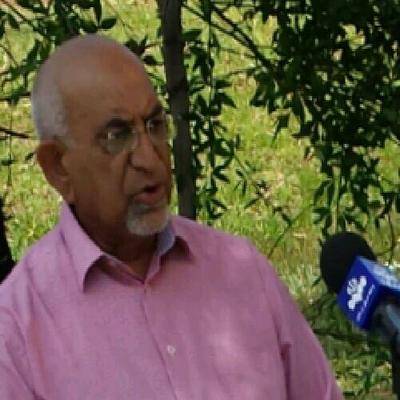Nothing could illustrate the stark contrast between a post-1994 democratic South Africa and Israel’s apartheid structures than the iconic photograph of Hector Pieterson taken by Sam Nzima. The picture of the dying 13-year-old Pieterson, who was shot by police in Soweto on 16 June 1976, was listed by Time magazine as one of the 100 most influential images of all time.
Sam Nzima died a few days ago at the age of 83. In 1976 he was covering the Soweto uprisings for The World newspaper, and often recalled the tragic events of that day, including how he hid the fateful film in his sock which police failed to find. Hounded and persecuted by the apartheid government’s security forces, Nzima’s future in journalism was destroyed. However, the elite right-wingers in control of Afrikanerdom knew that the photograph which was splashed across the front pages of influential papers around the world would spell doom for them. Indeed, Sam Nzima’s brilliant picture has been credited as being a key instrument in turning global opinion against apartheid.
“No picture more powerfully captured the horror and brutality of apartheid, or did more to galvanise international revulsion against it,” wrote Chris Barron in his obituary of Nzima in the Sunday Times. Barron observed that in terms of impact and effect, the photograph was in the same league as Associated Press photojournalist Nick Ut’s picture of a naked Vietnamese girl running down the road screaming in agony after being caught up in a US napalm strike, which changed American perceptions of the Vietnam War.
As fate would have it, Sam Nzima’s death and the recollection of the power of his camera planting “the seeds of international opposition that would eventually topple the racist regime…” — as Time put it — coincided with news of Israel’s bizarre attempt to replicate South Africa’s notorious apartheid laws targeting media freedom. It’s strange, I know, but true.
While South Africa mourns the great legacy of a renowned photojournalist, Israel is pursuing draconian measures which dinosaurs such as Vorster, Botha and their contemporaries would have applauded. A “new” bill before Israel’s Knesset (parliament) seeks to ban the taking of videos or photographs of Israeli soldiers in the process of arresting or subduing Palestinians. How “new” can it be when it is archaic by its association with apartheid South Africa?
If passed into law, the proposed legislation will result in sentences of between 5 to 10 years in prison for merely recording encounters between Israeli soldiers and Palestinians. Such is the desperate nature of this attempt by the settler-colonial regime to muzzle and criminalise the media — even social media — that the bill states clearly: “Anyone who shoots a video or a photo, or records soldiers while they are doing their job, with the aim of disturbing the morale of soldiers and citizens, will be sentenced to five years imprisonment. In case this is done with the aim of destabilising the state’s security, the perpetrator will be sentenced to ten years imprisonment.”
Just as Sam Nzima was punished for his picture of Pieterson by the securocrats of the old Nationalist Party, so too are professional and citizen journalists in the Occupied Palestinian Territories being targeted by Israel’s notorious occupation forces. Many have already been shot, injured and killed deliberately by Israel “Defence” Forces (IDF) snipers. The victims of these atrocious crimes are brave individuals who place themselves courageously, as Nzima did, between protesters and their uniformed killers. As the toll of unarmed Palestinian civilians who are summarily executed by Israeli occupation forces rises, so too does the number of journalists killed or injured in the line of duty in the besieged Gaza Strip.
The blanket veil to be thrown over Israel’s horrific military conduct is censorship of the worst type. It turns photojournalism into a crime and seeks to outlaw the Palestinian Sam Nzimas as well as fraternal members of the global media.
I know not whether the regime of Prime Minister Benjamin Netanyahu knows the power of Nzima’s photograph and the equally powerful impact it had in shaping public opinion against the racist dehumanisation of the Other. Clearly, though, the censorship bill is aimed at halting the severe damage being caused to the claims by Israel and its shameful apologists that it is a “civilised democracy” by images of the carnage, injustice and oppression carried out daily by its soldiers. It is a futile attempt to salvage the self-proclaimed “righteousness” and “purity of arms” which most historians and commentators confirm have never existed.
Indeed, the racist ideology of Zionism, whose adherents are bent on continuing the ethnic cleansing of Palestinians which commenced more than 70 years ago and is evident in the horrific bloodbath in Gaza, can never be reconciled with “righteous virtues”. The case of 16-year old Ahed Tamimi, who bravely stood up against Israel’s state terrorism, and whose “crime” was recorded by members of her family, provides an interesting insight into how the proposed legislation will criminalise citizen journalists instead of the perpetrators of injustice wearing Israeli military uniform. The victims are being turned into the villains, and the villains are being turned into victims.
Such attempts by the settler-colonial regime to conceal its hideous crimes against Palestinians will confirm yet again that Israel is intent on wiping out the indigenous population in occupied Palestine. This is a view held by many around the world, including governments. However, if the late Sam Nzima’s iconic photograph played a part in the downfall of apartheid in South Africa, that legacy looks set to live on in Palestine by helping to bring an end to Israel’s own racist, apartheid regime.
The views expressed in this article belong to the author and do not necessarily reflect the editorial policy of Middle East Monitor.












